See also
A Jupyter notebook version of this tutorial can be downloaded here.
Binned acquisition#
Bin based acquisition refers to a process of acquisition where raw data is collected, analyzed and processed and the result is stored in a bin (which is just a memory register). The result is stored in a bin after real-time demodulation, weighed integration, IQ rotation and discretisation. It also allows the averaging of those bins on the fly (see section Sequencer Acquisition).
The binning procedure allows for storing both integrated and discretized results on the fly as well as strong both single and averaged results using the same hardware. The results can be stored in a total of 131072 bins.
We will show this by using a QRM-RF and directly connecting outputs \(\text{O}^{[1-2]}\) to inputs \(\text{I}^{[1-2]}\), respectively. We will then use the QRM’s sequencers to sequence waveforms on the outputs and, simultaneously, acquire the resulting waveforms on the inputs.
Setup#
First, we are going to import the required packages.
[1]:
from __future__ import annotations
import json
import math
from typing import TYPE_CHECKING, Callable
import matplotlib.pyplot as plt
import numpy as np
import scipy.signal
from qcodes.instrument import find_or_create_instrument
from qblox_instruments import Cluster, ClusterType
if TYPE_CHECKING:
from numpy.typing import NDArray
from qblox_instruments.qcodes_drivers.module import QcmQrm
Scan For Clusters#
We scan for the available devices connected via ethernet using the Plug & Play functionality of the Qblox Instruments package (see Plug & Play for more info).
[2]:
!qblox-pnp list
Devices:
- 10.10.200.13 via 192.168.207.146/24 (reconfiguration needed!): cluster_mm 0.6.2 with name "QSE_1" and serial number 00015_2321_005
- 10.10.200.42 via 192.168.207.146/24 (reconfiguration needed!): cluster_mm 0.7.0 with name "QAE-I" and serial number 00015_2321_004
- 10.10.200.43 via 192.168.207.146/24 (reconfiguration needed!): cluster_mm 0.6.2 with name "QAE-2" and serial number 00015_2206_003
- 10.10.200.50 via 192.168.207.146/24 (reconfiguration needed!): cluster_mm 0.7.0 with name "cluster-mm" and serial number 00015_2219_003
- 10.10.200.53 via 192.168.207.146/24 (reconfiguration needed!): cluster_mm 0.7.0 with name "cluster-mm" and serial number 00015_2320_004
- 10.10.200.70 via 192.168.207.146/24 (reconfiguration needed!): cluster_mm 0.6.1 with name "cluster-mm" and serial number 123-456-789
- 10.10.200.80 via 192.168.207.146/24 (reconfiguration needed!): cluster_mm 0.6.1 with name "cluster-mm" and serial number not_valid
[3]:
cluster_ip = "10.10.200.42"
cluster_name = "cluster0"
Connect to Cluster#
We now make a connection with the Cluster.
[4]:
cluster = find_or_create_instrument(
Cluster,
recreate=True,
name=cluster_name,
identifier=cluster_ip,
dummy_cfg=(
{
2: ClusterType.CLUSTER_QCM,
4: ClusterType.CLUSTER_QRM,
6: ClusterType.CLUSTER_QCM_RF,
8: ClusterType.CLUSTER_QRM_RF,
}
if cluster_ip is None
else None
),
)
Get connected modules#
[5]:
def get_connected_modules(cluster: Cluster, filter_fn: Callable | None = None) -> dict[int, QcmQrm]:
def checked_filter_fn(mod: ClusterType) -> bool:
if filter_fn is not None:
return filter_fn(mod)
return True
return {
mod.slot_idx: mod for mod in cluster.modules if mod.present() and checked_filter_fn(mod)
}
[6]:
# QRM RF modules
modules = get_connected_modules(cluster, lambda mod: mod.is_qrm_type and mod.is_rf_type)
modules
[6]:
{8: <Module: cluster0_module8 of Cluster: cluster0>}
[7]:
readout_module = modules[8]
Reset the Cluster#
We reset the Cluster to enter a well-defined state. Note that resetting will clear all stored parameters, so resetting between experiments is usually not desirable.
[8]:
cluster.reset()
print(cluster.get_system_status())
Status: OKAY, Flags: NONE, Slot flags: NONE
c:\work\code\qblox_instruments_install\qblox_instruments\native\generic_func.py:1033: FutureWarning:
After June 2024, this feature is subject to removal in future releases.
Transition to an alternative is advised.
See https://qblox-qblox-instruments.readthedocs-hosted.com/en/main/getting_started/deprecated.html
warnings.warn(
c:\work\code\qblox_instruments_install\qblox_instruments\native\generic_func.py:77: FutureWarning:
After June 2024, this feature is subject to removal in future releases.
Transition to an alternative is advised.
See https://qblox-qblox-instruments.readthedocs-hosted.com/en/main/getting_started/deprecated.html
self._deprecation_warning()
c:\work\code\qblox_instruments_install\qblox_instruments\native\generic_func.py:129: FutureWarning:
After June 2024, this feature is subject to removal in future releases.
Transition to an alternative is advised.
See https://qblox-qblox-instruments.readthedocs-hosted.com/en/main/getting_started/deprecated.html
self._deprecation_warning()
Generate waveforms and weights#
Next, we need to create the waveforms used by the sequence for playback on the outputs as well as weights used by the sequence for weighed integrations. To keep it straightforward, we use the DC offset from the sequencers as our waveform and define waveform weights in the cell below.
[9]:
# Waveform and weight parameters
waveform_weight_length = 600 # nanoseconds
# These will be used as weights in the "Weighed acquisition" section
waveforms_weights = {
"gaussian": {
"data": scipy.signal.windows.gaussian(
waveform_weight_length, std=0.12 * waveform_weight_length
).tolist(),
"index": 0,
},
"sine": {
"data": [
math.sin((2 * math.pi / waveform_weight_length) * i)
for i in range(0, waveform_weight_length)
],
"index": 1,
},
"block": {"data": [1.0 for _ in range(0, waveform_weight_length)], "index": 2},
}
Specify acquisitions#
We also need to specify the acquisitions so that the instrument can allocate the required memory for its acquisition list. In this case we will create 4 acquisition specifications that each create multiple bins.
[10]:
# Acquisitions
acquisitions = {
"non_weighed": {"num_bins": 10, "index": 0},
"weighed": {"num_bins": 10, "index": 1},
"large": {"num_bins": 131072, "index": 2},
"avg": {"num_bins": 10, "index": 3},
"single": {"num_bins": 1, "index": 4},
}
Create Q1ASM program#
Now that we have the waveform and acquisition specifications for the sequence, we need a simple Q1ASM program that sequences the waveforms and triggers the acquisitions. In this case we will simply trigger 10 non-weighed acquisitions and store each acquisition in a separate bin.
[11]:
# Sequence program.
seq_prog = """
move 0,R0 #Loop iterator.
nop
loop: acquire 0,R0,1200 #Acquire bins and store them in "non_weighed" acquisition.
add R0,1,R0 #Increment iterator
nop #Wait a cycle for R0 to be available.
jlt R0,10,@loop #Run until number of iterations is done.
stop #Stop.
"""
Upload sequence#
Now that we have the waveform, weights and acquisition specifications and Q1ASM program, we can combine them in a sequence stored in a JSON file.
[12]:
# Add sequence program, waveforms, weights and acquisitions to single dictionary and write to JSON file.
sequence = {
"waveforms": waveforms_weights,
"weights": waveforms_weights,
"acquisitions": acquisitions,
"program": seq_prog,
}
with open("sequence.json", "w", encoding="utf-8") as file:
json.dump(sequence, file, indent=4)
file.close()
Let’s write the JSON file to the instruments. We will use sequencer 0, which will drive outputs \(\text{O}^{[1-2]}\) and acquire on inputs \(\text{I}^{[1-2]}\).
[13]:
# Upload sequence.
readout_module.sequencer0.sequence("sequence.json")
Play sequence#
The sequence has been uploaded to the instrument. Now we need to configure the sequencers. To keep it simple we will set a DC signal on the outputs of the instrument by enabling the sequencer offsets and disabling the modulation. These DC signals will then be acquired through the inputs. As such, we will also disable the demodulation on the input path. Furthermore, since we are running non-weighed integrations, we need to specify the integration length. This integration length will be used for every non-weighed integration moving forward. We will also put the integration result acquisition rotation to 0 degrees and acquisition threshold to 0.
[14]:
# Configure scope mode
readout_module.disconnect_outputs()
readout_module.disconnect_inputs()
readout_module.scope_acq_sequencer_select(0)
readout_module.scope_acq_trigger_mode_path0("sequencer")
readout_module.scope_acq_trigger_mode_path1("sequencer")
# Configure the channel map
readout_module.sequencer0.connect_sequencer("io0")
# Set the LO frequency. If this is commented out, the value is set to teh default value
readout_module.out0_in0_lo_freq(3e9)
readout_module.sequencer0.marker_ovr_en(True)
readout_module.sequencer0.marker_ovr_value(3)
# Configure the sequencer
readout_module.sequencer0.offset_awg_path0(0.5)
readout_module.sequencer0.offset_awg_path1(0.5)
readout_module.sequencer0.mod_en_awg(False)
readout_module.sequencer0.demod_en_acq(False)
readout_module.sequencer0.integration_length_acq(1000)
readout_module.sequencer0.thresholded_acq_rotation(0)
readout_module.sequencer0.thresholded_acq_threshold(0)
Now let’s start the sequence.
[15]:
# Arm and start sequencer.
readout_module.arm_sequencer(0)
readout_module.start_sequencer()
# Print status of sequencer.
print(readout_module.get_sequencer_status(0, 1))
Status: STOPPED, Flags: ACQ_SCOPE_DONE_PATH_0, ACQ_SCOPE_DONE_PATH_1, ACQ_BINNING_DONE
c:\work\code\qblox_instruments_install\qblox_instruments\native\generic_func.py:2414: FutureWarning:
After June 2024, this feature is subject to removal in future releases.
Transition to an alternative is advised.
See https://qblox-qblox-instruments.readthedocs-hosted.com/en/main/getting_started/deprecated.html
warnings.warn(
c:\work\code\qblox_instruments_install\qblox_instruments\native\generic_func.py:85: FutureWarning:
After June 2024, this feature is subject to removal in future releases.
Transition to an alternative is advised.
See https://qblox-qblox-instruments.readthedocs-hosted.com/en/main/getting_started/deprecated.html
self._deprecation_warning()
Retrieve acquisition#
Next, we will have a quick look at the input signal so that we can compare it to the integration results. Since we are integrating over a DC signal we are expecting the integration results to be roughly equal to the average DC value.
[16]:
# Wait for the sequencer to stop with a timeout period of one minute.
readout_module.get_acquisition_status(0, 1)
# Move acquisition data from temporary memory to acquisition list.
readout_module.store_scope_acquisition(0, "non_weighed")
# Get acquisition list from instrument.
non_weighed_acq = readout_module.get_acquisitions(0)["non_weighed"]
# Plot acquired signal on both inputs.
fig, ax = plt.subplots(1, 1, figsize=(15, 15 / 2 / 1.61))
ax.plot(non_weighed_acq["acquisition"]["scope"]["path0"]["data"])
ax.plot(non_weighed_acq["acquisition"]["scope"]["path1"]["data"])
ax.set_xlabel("Time (ns)")
ax.set_ylabel("Relative amplitude")
plt.show()
c:\work\code\qblox_instruments_install\qblox_instruments\native\generic_func.py:3210: FutureWarning:
After June 2024, this feature is subject to removal in future releases.
Transition to an alternative is advised.
See https://qblox-qblox-instruments.readthedocs-hosted.com/en/main/getting_started/deprecated.html
warnings.warn(
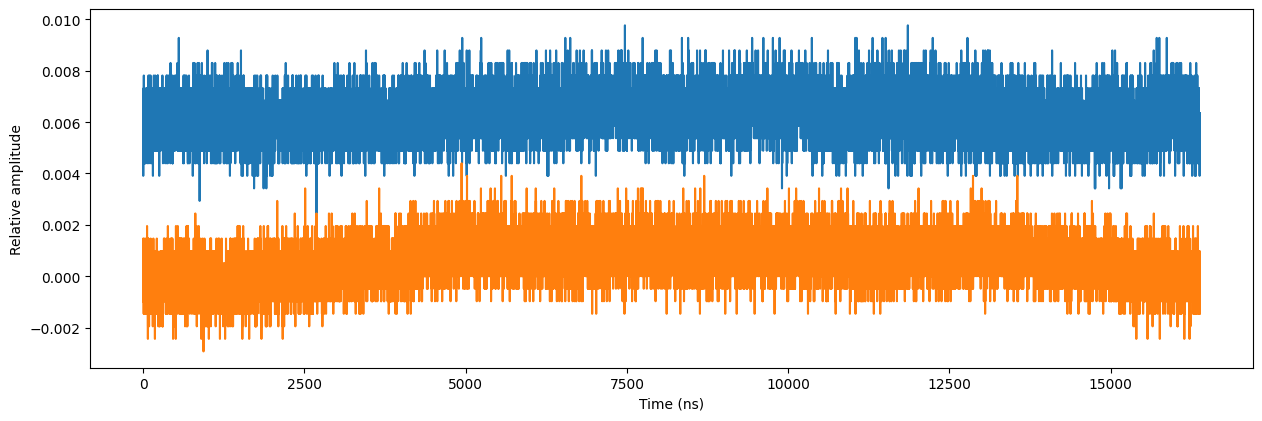
To check if the integration results match what we expect, we need to divide the integration results by the integration length which was set through the corresponding QCoDeS parameter. Note that the ‘valid’ key of the dictionary indicates if the bin was actually set during the sequence.
[17]:
int_len = readout_module.sequencer0.integration_length_acq()
bins = non_weighed_acq["acquisition"]["bins"]
bins["integration"]["path0"] = [(val / int_len) for val in bins["integration"]["path0"]]
bins["integration"]["path1"] = [(val / int_len) for val in bins["integration"]["path1"]]
bins
[17]:
{'integration': {'path0': [0.006601856375183195,
0.006504640937957987,
0.006375183194919394,
0.006277479237909136,
0.00624523693209575,
0.006181729360039082,
0.006108451392281387,
0.00591695163654128,
0.005869565217391305,
0.0060639960918417194],
'path1': [0.0011104054714215926,
0.0010972154372252076,
0.0010415241817293601,
0.0009692232535417684,
0.0007938446507083537,
0.0008778700537371763,
0.0005095261358085002,
-2.8822667318026378e-05,
-0.0003453834880312653,
-0.00019247679531021007]},
'threshold': [1.0, 1.0, 1.0, 1.0, 1.0, 1.0, 1.0, 1.0, 1.0, 1.0],
'avg_cnt': [1, 1, 1, 1, 1, 1, 1, 1, 1, 1]}
Weighed acquisition#
In the following, we look into weighed integrations. This refers to integration with a weighting given by a particular waveform that we specified earlier. This is equivalent to multiplying the acquired trace with a function (which specifies the weighting) and integrating the result.
To do this, we will need to modify the sequence program slightly and reupload it. We will be using a gaussian weight to integrate over input path 0 and a sine weight to integrate over input path 1. The integration length of a weighed integration is determined by the weight length.
[18]:
# Sequence program.
seq_prog = """
move 0,R0 #Loop iterator.
move 0,R1 #Weight for path 0.
move 1,R2 #Weight for path 1.
nop
loop: acquire_weighed 1,R0,R1,R2,1200 #Acquire bins and store them in "weighed" acquisition.
add R0,1,R0 #Increment iterator
nop #Wait a cycle for R0 to be available.
jlt R0,10,@loop #Run until number of iterations is done.
stop #Stop.
"""
[19]:
# Add sequence program, waveforms, weights and acquisitions to single dictionary and write to JSON file.
sequence = {
"waveforms": waveforms_weights,
"weights": waveforms_weights,
"acquisitions": acquisitions,
"program": seq_prog,
}
with open("sequence.json", "w", encoding="utf-8") as file:
json.dump(sequence, file, indent=4)
file.close()
[20]:
# Upload sequence.
readout_module.sequencer0.sequence("sequence.json")
Let’s start the sequence and retrieve the results.
[21]:
# Arm and start sequencer.
readout_module.arm_sequencer(0)
readout_module.start_sequencer()
# Print status of sequencer.
print(readout_module.get_sequencer_status(0, 1))
Status: STOPPED, Flags: ACQ_SCOPE_DONE_PATH_0, ACQ_SCOPE_DONE_PATH_1, ACQ_BINNING_DONE
[22]:
# Wait for the sequencer to stop with a timeout period of one minute.
readout_module.get_acquisition_status(0, 1)
# Get acquisition list from instrument.
weighed_acq = readout_module.get_acquisitions(0)["weighed"]
To check if the integration results match what we expect we need to divide the integration results by the integration length again. In this case the integration length is determined by the length of the weights.
[23]:
int_len = waveform_weight_length
bins = weighed_acq["acquisition"]["bins"]
bins["integration"]["path0"] = [(val / int_len) for val in bins["integration"]["path0"]]
bins["integration"]["path1"] = [(val / int_len) for val in bins["integration"]["path1"]]
bins
[23]:
{'integration': {'path0': [0.00195841623492607,
0.0019081589963650977,
0.0018741296675177776,
0.0017611034835414334,
0.00185224332883316,
0.0018453860734233862,
0.0018474535916148016,
0.0018988989172934651,
0.00197503990851053,
0.001993148392677629],
'path1': [2.578630326076814e-06,
-7.865796988487527e-05,
5.8956486418696536e-05,
1.3342612106778763e-05,
-4.1967675916245066e-05,
3.8457906674026684e-05,
2.8119122459046795e-05,
-7.024550167624893e-05,
-3.8263007883377656e-05,
-9.678117089943088e-06]},
'threshold': [1.0, 1.0, 1.0, 1.0, 1.0, 1.0, 1.0, 1.0, 1.0, 1.0],
'avg_cnt': [1, 1, 1, 1, 1, 1, 1, 1, 1, 1]}
Large number of bins#
The QRM supports up to 131072 bins. To show that we need to change the program slightly. We will use the non-weighed acquisition program, however, we will now loop over the maximum number of acquisitions while storing each result in a separate bin.
[24]:
# Sequence program.
seq_prog = """
move 0,R0 #Loop iterator.
nop
loop: acquire 2,R0,1200 #Acquire bins and store them in "large" acquisition.
add R0,1,R0 #Increment iterator
nop #Wait a cycle for R0 to be available.
jlt R0,131072,@loop #Run until number of iterations is done.
stop #Stop.
"""
[25]:
# Add sequence program, waveforms, weights and acquisitions to single dictionary and write to JSON file.
sequence = {
"waveforms": waveforms_weights,
"weights": waveforms_weights,
"acquisitions": acquisitions,
"program": seq_prog,
}
with open("sequence.json", "w", encoding="utf-8") as file:
json.dump(sequence, file, indent=4)
file.close()
[26]:
# Upload sequence.
readout_module.sequencer0.sequence("sequence.json")
Let’s start the sequence and retrieve the results.
[27]:
# Arm and start sequencer.
readout_module.arm_sequencer(0)
readout_module.start_sequencer()
# Print status of sequencer.
print(readout_module.get_sequencer_status(0, 1))
Status: STOPPED, Flags: ACQ_SCOPE_DONE_PATH_0, ACQ_SCOPE_DONE_PATH_1, ACQ_BINNING_DONE
[28]:
# Wait for the sequencer to stop with a timeout period of one minute.
readout_module.get_acquisition_status(0, 1)
# Get acquisition list from instrument.
large_acq = readout_module.get_acquisitions(0)["large"]
Since the number of bins is now to large to simply print, we will check the number of bins and we will check the bins for NaN values which indicate that a bin is not written.
[29]:
int_len = readout_module.sequencer0.integration_length_acq()
bins = large_acq["acquisition"]["bins"]
bins["integration"]["path0"] = [(val / int_len) for val in bins["integration"]["path0"]]
bins["integration"]["path1"] = [(val / int_len) for val in bins["integration"]["path1"]]
print("Number of bins: {}".format(len(bins["avg_cnt"])))
for it, val in enumerate(bins["integration"]["path0"]):
if math.isnan(val):
raise Exception(f"NaN found at index {it}.")
for it, val in enumerate(bins["integration"]["path1"]):
if math.isnan(val):
raise Exception(f"NaN found at index {it}.")
print("All values are valid.")
Number of bins: 131072
All values are valid.
We will also plot the integration results in every bin to visualize the contents.
[30]:
# Plot bins
fig, ax = plt.subplots(1, 1, figsize=(15, 15 / 2 / 1.61))
ax.plot(bins["integration"]["path0"])
ax.plot(bins["integration"]["path1"])
ax.set_xlabel("Bin index")
ax.set_ylabel("Relative amplitude")
plt.show()
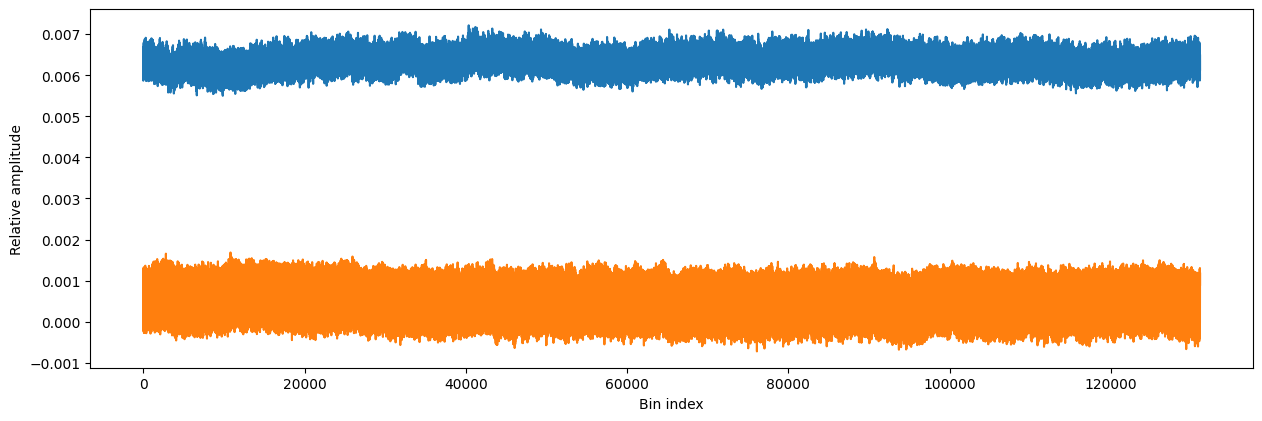
Averaging#
As you may have noticed, the acquisition results also contain an average counter. This average counter reflects the number of times a bin has been averaged during the sequence. Each time the sequencer writes to the same bin the results are automatically accumulated and the average counter is increased. Upon retrieval of the acquisition results, each result is divided by the average counter and therefore automatically averaged. To show this we will change the sequence one last time. This time we will average 10 bins a 1000 times each.
[31]:
# Sequence program.
seq_prog = """
move 0,R1 #Average iterator.
avg: move 0,R0 #Bin iterator.
nop
loop: acquire 3,R0,1200 #Acquire bins and store them in "avg" acquisition.
add R0,1,R0 #Increment bin iterator
nop #Wait a cycle for R0 to be available.
jlt R0,10,@loop #Run until number of avg iterations is done.
add R1,1,R1 #Increment avg iterator
nop #Wait a cycle for R1 to be available.
jlt R1,1000,@avg #Run until number of average iterations is done.
stop #Stop.
"""
[32]:
# Add sequence program, waveforms, weights and acquisitions to single dictionary and write to JSON file.
sequence = {
"waveforms": waveforms_weights,
"weights": waveforms_weights,
"acquisitions": acquisitions,
"program": seq_prog,
}
with open("sequence.json", "w", encoding="utf-8") as file:
json.dump(sequence, file, indent=4)
file.close()
[33]:
# Upload sequence.
readout_module.sequencer0.sequence("sequence.json")
Let’s start the sequence and retrieve the results.
[34]:
# Arm and start sequencer.
readout_module.arm_sequencer(0)
readout_module.start_sequencer()
# Print status of sequencer.
print(readout_module.get_sequencer_status(0, 1))
Status: STOPPED, Flags: ACQ_SCOPE_DONE_PATH_0, ACQ_SCOPE_DONE_PATH_1, ACQ_BINNING_DONE
Note that the average count of each bin is now set to a 1000.
[35]:
# Wait for the sequencer to stop with a timeout period of one minute.
readout_module.get_acquisition_status(0, 1)
# Get acquisition list from instrument.
avg_acq = readout_module.get_acquisitions(0)["avg"]
[36]:
int_len = readout_module.sequencer0.integration_length_acq()
bins = avg_acq["acquisition"]["bins"]
bins["integration"]["path0"] = [(val / int_len) for val in bins["integration"]["path0"]]
bins["integration"]["path1"] = [(val / int_len) for val in bins["integration"]["path1"]]
bins
[36]:
{'integration': {'path0': [0.006289778700537371,
0.00628827943331705,
0.0062916262823644355,
0.006289062042012702,
0.006291643380556912,
0.006289085979482169,
0.006292396678065462,
0.006289933561309233,
0.006292039081582803,
0.006292086468001954],
'path1': [0.0006263634587200781,
0.0006319364924279434,
0.0006280854909623839,
0.0006287366878358574,
0.0006320600879335613,
0.0006245490962383976,
0.0006299926722032242,
0.0006256008793356131,
0.0006244875427454812,
0.0006260341963849535]},
'threshold': [1.0, 1.0, 1.0, 1.0, 1.0, 1.0, 1.0, 1.0, 1.0, 1.0],
'avg_cnt': [1000, 1000, 1000, 1000, 1000, 1000, 1000, 1000, 1000, 1000]}
Characterizing Input Offset#
The Qblox QRM and QRM-RF use analog-to-digital converters (ADCs) to digitize the incoming analog signals. Due to thermal, manufacturing effects or other factors, the digitized signal is not centered around 0V but has a small offset, which we will hereby refer to as input (ADC) offset. This input offset can get demodulated and integrated by the hardware along with the signal. The integrated offset can then show up as oscillations in the result, e.g. during a frequency sweep. In this section we show how to measure and calibrate away this offset to prevent such effects.
Measuring the Offset#
We will use a simple scope acquisition to determine the mean value of this offset. Before proceeding, please make sure that there is no DC signal going into to your QRM.
[37]:
cluster.reset()
[38]:
def acquire_scope_and_calc_offsets() -> tuple[float, float]:
seq_prog = """
acquire 4,0,16380 #Acquire waveforms and wait remaining duration of scope acquisition.
stop #Stop.
"""
# Add sequence program, waveforms, weights and acquisitions to single dictionary and write to JSON file.
sequence = {
"waveforms": {},
"weights": {},
"acquisitions": acquisitions,
"program": seq_prog,
}
with open("sequence.json", "w", encoding="utf-8") as file:
json.dump(sequence, file, indent=4)
file.close()
# Upload sequence.
readout_module.sequencer0.sequence("sequence.json")
# Arm and start sequencer.
readout_module.arm_sequencer(0)
readout_module.start_sequencer()
# Wait for the acquisition to stop
readout_module.get_acquisition_status(0, 1)
# Retrieve results
readout_module.store_scope_acquisition(0, "single")
single_acq = readout_module.get_acquisitions(0)
I_data = np.array(single_acq["single"]["acquisition"]["scope"]["path0"]["data"])
Q_data = np.array(single_acq["single"]["acquisition"]["scope"]["path1"]["data"])
# Plot results
fig, ax = plt.subplots(1, 1, figsize=(15, 15 / 2 / 1.61))
ax.plot(I_data, label="I")
ax.plot(Q_data, label="Q")
ax.set_xlabel("Time (ns)", fontsize=20)
ax.set_ylabel("Relative amplitude", fontsize=20)
plt.legend()
plt.show()
# Print mean offset values
I_offset, Q_offset = np.mean(I_data), np.mean(Q_data)
print(f"I Offset : {I_offset*1e3:.3f} mV \nQ Offset : {Q_offset*1e3:.3f} mV")
return I_offset, Q_offset
[39]:
readout_module.scope_acq_sequencer_select(0)
readout_module.scope_acq_trigger_mode_path0("sequencer")
readout_module.scope_acq_trigger_mode_path1("sequencer")
[40]:
I_offset, Q_offset = acquire_scope_and_calc_offsets()
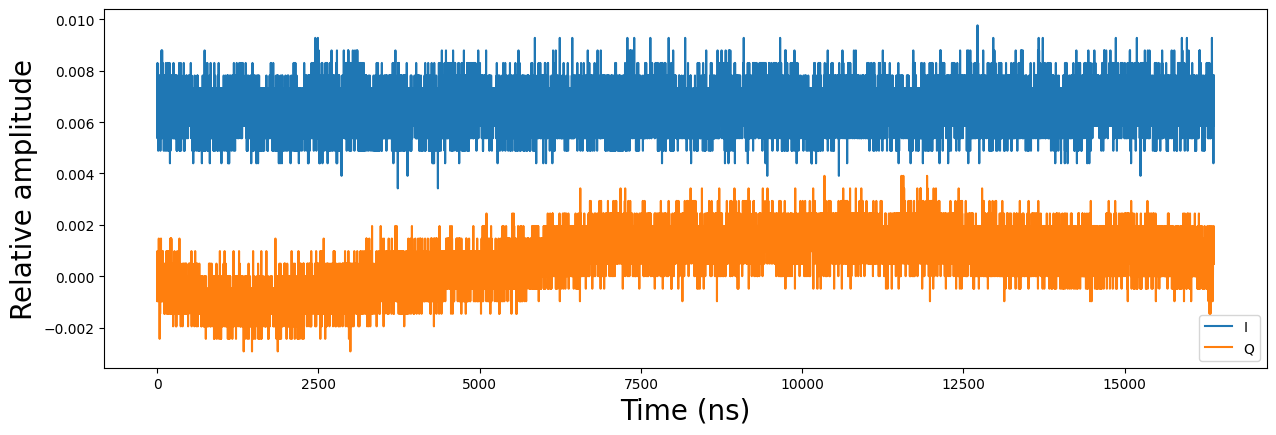
I Offset : 6.538 mV
Q Offset : 0.642 mV
Correcting the Offsets#
One can correct for these offsets by changing the reference Voltage of the ADC. This can be done using the parameters QRM_RF.in0_offset_path0 and QRM_RF.in0_offset_path1.
[41]:
readout_module.in0_offset_path0(-I_offset) # Negative sign to compensate for the offset
readout_module.in0_offset_path1(-Q_offset)
Repeating the offset measurement as before, we get:
[42]:
I_offset, Q_offset = acquire_scope_and_calc_offsets()
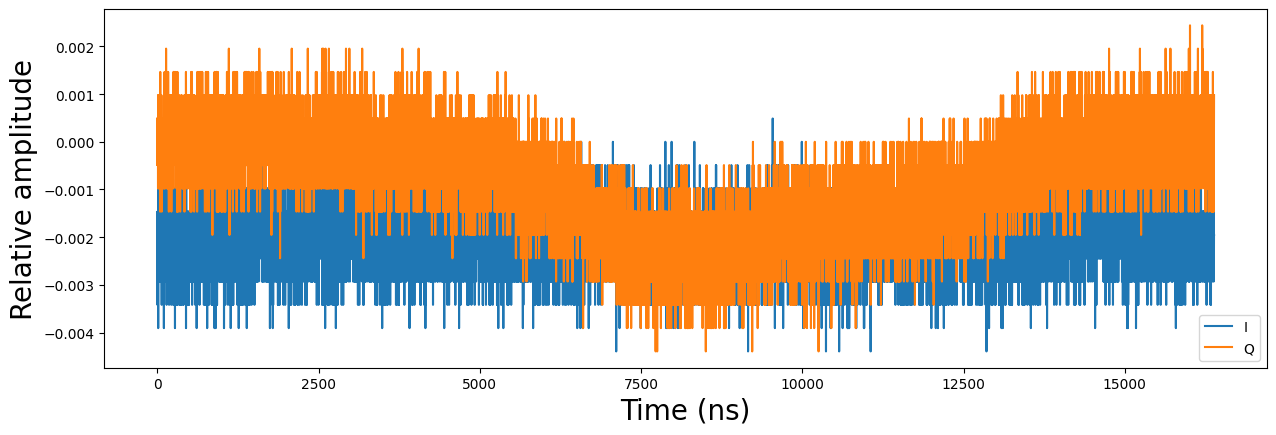
I Offset : -2.020 mV
Q Offset : -0.857 mV
Advanced ADC Offset Calibration : Curve Fitting Method#
As you may have noticed in the previous section, manually compensating for the offset does not entirely eliminate it, leaving some residual offset. This is because of the non-linear effects of these input offsets. To circumvent this, one can curve-fit the dependence of the set offset value on the actual offset value. In the following section, we do this by fitting 10 setpoints against the 10 measured offset values from the binned acquisition with a function. We then find the roots/zeros of this function to set the actual offset to zero.
[43]:
# Define helper functions
def get_real_root(coeffs: NDArray) -> NDArray:
for root in np.roots(coeffs):
if root.imag == 0:
output = root
return np.real(output)
def get_curve(x: NDArray, coeffs: NDArray) -> NDArray:
y = 0
for i, coeff in enumerate(coeffs):
y += coeff * x ** (len(coeffs) - (i + 1))
return y
[44]:
seq_prog = """
move 0,R0 #Loop iterator.
nop
loop: acquire 0,R0,16000 #Acquire bins and store them in "non_weighed" acquisition.
add R0,1,R0 #Increment iterator
nop #Wait a cycle for R0 to be available.
jlt R0,100,@loop #Run until number of iterations is done.
stop #Stop.
"""
[45]:
# Add sequence program, waveforms, weights and acquisitions to single dictionary and write to JSON file.
sequence = {
"waveforms": {},
"weights": {},
"acquisitions": acquisitions,
"program": seq_prog,
}
with open("sequence.json", "w", encoding="utf-8") as file:
json.dump(sequence, file, indent=4)
file.close()
[46]:
# Upload sequence.
readout_module.sequencer0.sequence("sequence.json")
Let’s start the sequence and retrieve the results.
[47]:
# Start out by setting the original offset values obtained from inspecting the scope
readout_module.in0_offset_path0(-np.sign(I_offset) * I_offset)
readout_module.in0_offset_path1(-np.sign(Q_offset) * Q_offset)
# Set the domain (X) around these original offset values
I_offset_setpoints = np.linspace(
-10e-3 + readout_module.in0_offset_path0(), +10e-3 + readout_module.in0_offset_path0(), 12
)
Q_offset_setpoints = np.linspace(
-10e-3 + readout_module.in0_offset_path1(), +10e-3 + readout_module.in0_offset_path1(), 12
)
int_len = readout_module.sequencer0.integration_length_acq()
I_offset_sum, Q_offset_sum = [], []
for I_offset_i, Q_offset_i in zip(I_offset_setpoints, Q_offset_setpoints):
readout_module.delete_acquisition_data(0, all=True)
readout_module.in0_offset_path0(I_offset_i)
readout_module.in0_offset_path1(Q_offset_i)
readout_module.arm_sequencer(0)
readout_module.start_sequencer()
readout_module.get_acquisition_status(0, 1)
non_weighed_acq = readout_module.get_acquisitions(0)["non_weighed"]
I_offset_sum += [
np.mean(non_weighed_acq["acquisition"]["bins"]["integration"]["path0"]) * 1e3 / int_len
]
Q_offset_sum += [
np.mean(non_weighed_acq["acquisition"]["bins"]["integration"]["path1"]) * 1e3 / int_len
]
output = {
"offsets_I": I_offset_setpoints,
"offsets_Q": Q_offset_setpoints,
"I_m": I_offset_sum,
"Q_m": Q_offset_sum,
}
[48]:
plt.figure()
## Fit I offset and find its root
coeffs = np.polyfit(np.array(output["offsets_I"]) * 1e3, np.array(output["I_m"]), 3)
new_I_offset = get_real_root(coeffs)
plt.plot(
output["offsets_I"] * 1e3,
get_curve(np.array(output["offsets_I"]) * 1e3, coeffs),
c="b",
label="I",
)
plt.scatter(output["offsets_I"] * 1e3, output["I_m"], c="b")
# Fit Q offset and find its root
coeffs = np.polyfit(np.array(output["offsets_Q"]) * 1e3, np.array(output["Q_m"]), 3)
new_Q_offset = get_real_root(coeffs)
plt.plot(
output["offsets_Q"] * 1e3,
get_curve(np.array(output["offsets_Q"]) * 1e3, coeffs),
c="r",
label="Q",
)
plt.scatter(output["offsets_Q"] * 1e3, output["Q_m"], c="r")
# Plot zeros on the plot
plt.axvline(x=new_I_offset)
plt.axvline(x=new_Q_offset)
plt.axhline(y=0)
plt.xlabel("Set Offset (mV)")
plt.ylabel("Observed Offset (mV)")
plt.legend()
plt.grid()
print(
f"Offset setpoints corresponding to observed zero offset: \nI offset: {new_I_offset}\nQ offset: {new_Q_offset}"
)
Offset setpoints corresponding to observed zero offset:
I offset: -4.951338967773404
Q offset: -0.23387345963966613
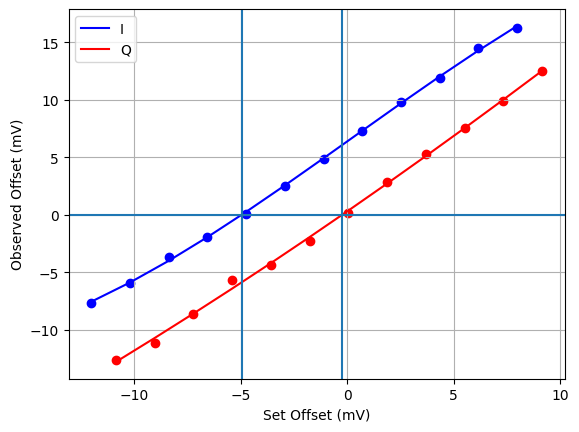
Applying The Offset Corrections#
Using the zeros obtained from the curve fitting, we attempt to correct for the input offsets again:
[49]:
readout_module.in0_offset_path0(new_I_offset * 1e-3) # Multiplying by 1e-3 to convert to mV
readout_module.in0_offset_path0(new_Q_offset * 1e-3)
[50]:
I_offset_calib, Q_offset_calib = acquire_scope_and_calc_offsets()
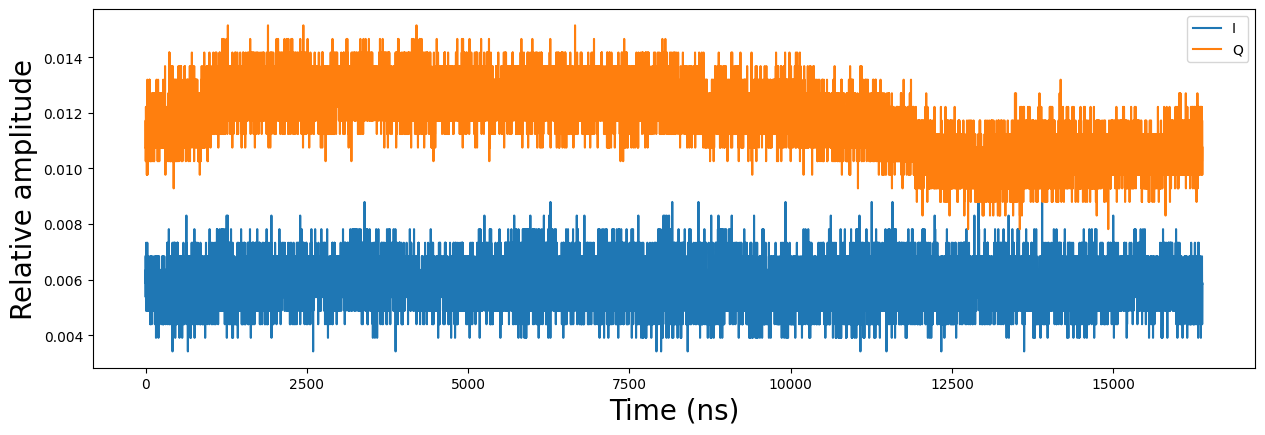
I Offset : 5.813 mV
Q Offset : 11.793 mV
As you can see, you have calibrated away the offsets to sub-millivolt range, which is at the limit of the ADC resolution.
We advise you to check/calibrate these offset values every few days if they are vital for your experiments, especially when you are dealing with low input signals.
Stop#
Finally, let’s stop the sequencers if they haven’t already and close the instrument connection. One can also display a detailed snapshot containing the instrument parameters before closing the connection by uncommenting the corresponding lines.
[51]:
# Stop sequencer.
readout_module.stop_sequencer()
# Print status of sequencer.
print(readout_module.get_sequencer_status(0))
print()
# Print an overview of the instrument parameters.
print("Snapshot:")
readout_module.print_readable_snapshot(update=True)
# Reset the cluster
cluster.reset()
print(cluster.get_system_status())
Status: STOPPED, Flags: FORCED_STOP, ACQ_SCOPE_DONE_PATH_0, ACQ_SCOPE_DONE_PATH_1, ACQ_BINNING_DONE
Snapshot:
cluster0_module8:
parameter value
--------------------------------------------------------------------------------
in0_att : 0 (dB)
in0_offset_path0 : -0.00023387 (V)
in0_offset_path1 : 0.0091428 (V)
marker0_inv_en : False
marker1_inv_en : False
out0_att : 0 (dB)
out0_in0_lo_en : True
out0_in0_lo_freq : 6000000000 (Hz)
out0_offset_path0 : 7.625 (mV)
out0_offset_path1 : 7.625 (mV)
present : True
scope_acq_avg_mode_en_path0 : False
scope_acq_avg_mode_en_path1 : False
scope_acq_sequencer_select : 0
scope_acq_trigger_level_path0 : 0
scope_acq_trigger_level_path1 : 0
scope_acq_trigger_mode_path0 : sequencer
scope_acq_trigger_mode_path1 : sequencer
cluster0_module8_sequencer0:
parameter value
--------------------------------------------------------------------------------
connect_acq : in0
connect_out0 : IQ
cont_mode_en_awg_path0 : False
cont_mode_en_awg_path1 : False
cont_mode_waveform_idx_awg_path0 : 0
cont_mode_waveform_idx_awg_path1 : 0
demod_en_acq : False
gain_awg_path0 : 1
gain_awg_path1 : 1
integration_length_acq : 1024
marker_ovr_en : False
marker_ovr_value : 0
mixer_corr_gain_ratio : 1
mixer_corr_phase_offset_degree : -0
mod_en_awg : False
nco_freq : 0 (Hz)
nco_phase_offs : 0 (Degrees)
nco_prop_delay_comp : 0 (ns)
nco_prop_delay_comp_en : False (ns)
offset_awg_path0 : 0
offset_awg_path1 : 0
sync_en : False
thresholded_acq_marker_address : 1
thresholded_acq_marker_en : False
thresholded_acq_marker_invert : False
thresholded_acq_rotation : 0 (Degrees)
thresholded_acq_threshold : 0
thresholded_acq_trigger_address : 1
thresholded_acq_trigger_en : False
thresholded_acq_trigger_invert : False
trigger10_count_threshold : 1
trigger10_threshold_invert : False
trigger11_count_threshold : 1
trigger11_threshold_invert : False
trigger12_count_threshold : 1
trigger12_threshold_invert : False
trigger13_count_threshold : 1
trigger13_threshold_invert : False
trigger14_count_threshold : 1
trigger14_threshold_invert : False
trigger15_count_threshold : 1
trigger15_threshold_invert : False
trigger1_count_threshold : 1
trigger1_threshold_invert : False
trigger2_count_threshold : 1
trigger2_threshold_invert : False
trigger3_count_threshold : 1
trigger3_threshold_invert : False
trigger4_count_threshold : 1
trigger4_threshold_invert : False
trigger5_count_threshold : 1
trigger5_threshold_invert : False
trigger6_count_threshold : 1
trigger6_threshold_invert : False
trigger7_count_threshold : 1
trigger7_threshold_invert : False
trigger8_count_threshold : 1
trigger8_threshold_invert : False
trigger9_count_threshold : 1
trigger9_threshold_invert : False
upsample_rate_awg_path0 : 0
upsample_rate_awg_path1 : 0
cluster0_module8_sequencer1:
parameter value
--------------------------------------------------------------------------------
connect_acq : in0
connect_out0 : IQ
cont_mode_en_awg_path0 : False
cont_mode_en_awg_path1 : False
cont_mode_waveform_idx_awg_path0 : 0
cont_mode_waveform_idx_awg_path1 : 0
demod_en_acq : False
gain_awg_path0 : 1
gain_awg_path1 : 1
integration_length_acq : 1024
marker_ovr_en : False
marker_ovr_value : 0
mixer_corr_gain_ratio : 1
mixer_corr_phase_offset_degree : -0
mod_en_awg : False
nco_freq : 0 (Hz)
nco_phase_offs : 0 (Degrees)
nco_prop_delay_comp : 0 (ns)
nco_prop_delay_comp_en : False (ns)
offset_awg_path0 : 0
offset_awg_path1 : 0
sync_en : False
thresholded_acq_marker_address : 1
thresholded_acq_marker_en : False
thresholded_acq_marker_invert : False
thresholded_acq_rotation : 0 (Degrees)
thresholded_acq_threshold : 0
thresholded_acq_trigger_address : 1
thresholded_acq_trigger_en : False
thresholded_acq_trigger_invert : False
trigger10_count_threshold : 1
trigger10_threshold_invert : False
trigger11_count_threshold : 1
trigger11_threshold_invert : False
trigger12_count_threshold : 1
trigger12_threshold_invert : False
trigger13_count_threshold : 1
trigger13_threshold_invert : False
trigger14_count_threshold : 1
trigger14_threshold_invert : False
trigger15_count_threshold : 1
trigger15_threshold_invert : False
trigger1_count_threshold : 1
trigger1_threshold_invert : False
trigger2_count_threshold : 1
trigger2_threshold_invert : False
trigger3_count_threshold : 1
trigger3_threshold_invert : False
trigger4_count_threshold : 1
trigger4_threshold_invert : False
trigger5_count_threshold : 1
trigger5_threshold_invert : False
trigger6_count_threshold : 1
trigger6_threshold_invert : False
trigger7_count_threshold : 1
trigger7_threshold_invert : False
trigger8_count_threshold : 1
trigger8_threshold_invert : False
trigger9_count_threshold : 1
trigger9_threshold_invert : False
upsample_rate_awg_path0 : 0
upsample_rate_awg_path1 : 0
cluster0_module8_sequencer2:
parameter value
--------------------------------------------------------------------------------
connect_acq : in0
connect_out0 : IQ
cont_mode_en_awg_path0 : False
cont_mode_en_awg_path1 : False
cont_mode_waveform_idx_awg_path0 : 0
cont_mode_waveform_idx_awg_path1 : 0
demod_en_acq : False
gain_awg_path0 : 1
gain_awg_path1 : 1
integration_length_acq : 1024
marker_ovr_en : False
marker_ovr_value : 0
mixer_corr_gain_ratio : 1
mixer_corr_phase_offset_degree : -0
mod_en_awg : False
nco_freq : 0 (Hz)
nco_phase_offs : 0 (Degrees)
nco_prop_delay_comp : 0 (ns)
nco_prop_delay_comp_en : False (ns)
offset_awg_path0 : 0
offset_awg_path1 : 0
sync_en : False
thresholded_acq_marker_address : 1
thresholded_acq_marker_en : False
thresholded_acq_marker_invert : False
thresholded_acq_rotation : 0 (Degrees)
thresholded_acq_threshold : 0
thresholded_acq_trigger_address : 1
thresholded_acq_trigger_en : False
thresholded_acq_trigger_invert : False
trigger10_count_threshold : 1
trigger10_threshold_invert : False
trigger11_count_threshold : 1
trigger11_threshold_invert : False
trigger12_count_threshold : 1
trigger12_threshold_invert : False
trigger13_count_threshold : 1
trigger13_threshold_invert : False
trigger14_count_threshold : 1
trigger14_threshold_invert : False
trigger15_count_threshold : 1
trigger15_threshold_invert : False
trigger1_count_threshold : 1
trigger1_threshold_invert : False
trigger2_count_threshold : 1
trigger2_threshold_invert : False
trigger3_count_threshold : 1
trigger3_threshold_invert : False
trigger4_count_threshold : 1
trigger4_threshold_invert : False
trigger5_count_threshold : 1
trigger5_threshold_invert : False
trigger6_count_threshold : 1
trigger6_threshold_invert : False
trigger7_count_threshold : 1
trigger7_threshold_invert : False
trigger8_count_threshold : 1
trigger8_threshold_invert : False
trigger9_count_threshold : 1
trigger9_threshold_invert : False
upsample_rate_awg_path0 : 0
upsample_rate_awg_path1 : 0
cluster0_module8_sequencer3:
parameter value
--------------------------------------------------------------------------------
connect_acq : in0
connect_out0 : IQ
cont_mode_en_awg_path0 : False
cont_mode_en_awg_path1 : False
cont_mode_waveform_idx_awg_path0 : 0
cont_mode_waveform_idx_awg_path1 : 0
demod_en_acq : False
gain_awg_path0 : 1
gain_awg_path1 : 1
integration_length_acq : 1024
marker_ovr_en : False
marker_ovr_value : 0
mixer_corr_gain_ratio : 1
mixer_corr_phase_offset_degree : -0
mod_en_awg : False
nco_freq : 0 (Hz)
nco_phase_offs : 0 (Degrees)
nco_prop_delay_comp : 0 (ns)
nco_prop_delay_comp_en : False (ns)
offset_awg_path0 : 0
offset_awg_path1 : 0
sync_en : False
thresholded_acq_marker_address : 1
thresholded_acq_marker_en : False
thresholded_acq_marker_invert : False
thresholded_acq_rotation : 0 (Degrees)
thresholded_acq_threshold : 0
thresholded_acq_trigger_address : 1
thresholded_acq_trigger_en : False
thresholded_acq_trigger_invert : False
trigger10_count_threshold : 1
trigger10_threshold_invert : False
trigger11_count_threshold : 1
trigger11_threshold_invert : False
trigger12_count_threshold : 1
trigger12_threshold_invert : False
trigger13_count_threshold : 1
trigger13_threshold_invert : False
trigger14_count_threshold : 1
trigger14_threshold_invert : False
trigger15_count_threshold : 1
trigger15_threshold_invert : False
trigger1_count_threshold : 1
trigger1_threshold_invert : False
trigger2_count_threshold : 1
trigger2_threshold_invert : False
trigger3_count_threshold : 1
trigger3_threshold_invert : False
trigger4_count_threshold : 1
trigger4_threshold_invert : False
trigger5_count_threshold : 1
trigger5_threshold_invert : False
trigger6_count_threshold : 1
trigger6_threshold_invert : False
trigger7_count_threshold : 1
trigger7_threshold_invert : False
trigger8_count_threshold : 1
trigger8_threshold_invert : False
trigger9_count_threshold : 1
trigger9_threshold_invert : False
upsample_rate_awg_path0 : 0
upsample_rate_awg_path1 : 0
cluster0_module8_sequencer4:
parameter value
--------------------------------------------------------------------------------
connect_acq : in0
connect_out0 : IQ
cont_mode_en_awg_path0 : False
cont_mode_en_awg_path1 : False
cont_mode_waveform_idx_awg_path0 : 0
cont_mode_waveform_idx_awg_path1 : 0
demod_en_acq : False
gain_awg_path0 : 1
gain_awg_path1 : 1
integration_length_acq : 1024
marker_ovr_en : False
marker_ovr_value : 0
mixer_corr_gain_ratio : 1
mixer_corr_phase_offset_degree : -0
mod_en_awg : False
nco_freq : 0 (Hz)
nco_phase_offs : 0 (Degrees)
nco_prop_delay_comp : 0 (ns)
nco_prop_delay_comp_en : False (ns)
offset_awg_path0 : 0
offset_awg_path1 : 0
sync_en : False
thresholded_acq_marker_address : 1
thresholded_acq_marker_en : False
thresholded_acq_marker_invert : False
thresholded_acq_rotation : 0 (Degrees)
thresholded_acq_threshold : 0
thresholded_acq_trigger_address : 1
thresholded_acq_trigger_en : False
thresholded_acq_trigger_invert : False
trigger10_count_threshold : 1
trigger10_threshold_invert : False
trigger11_count_threshold : 1
trigger11_threshold_invert : False
trigger12_count_threshold : 1
trigger12_threshold_invert : False
trigger13_count_threshold : 1
trigger13_threshold_invert : False
trigger14_count_threshold : 1
trigger14_threshold_invert : False
trigger15_count_threshold : 1
trigger15_threshold_invert : False
trigger1_count_threshold : 1
trigger1_threshold_invert : False
trigger2_count_threshold : 1
trigger2_threshold_invert : False
trigger3_count_threshold : 1
trigger3_threshold_invert : False
trigger4_count_threshold : 1
trigger4_threshold_invert : False
trigger5_count_threshold : 1
trigger5_threshold_invert : False
trigger6_count_threshold : 1
trigger6_threshold_invert : False
trigger7_count_threshold : 1
trigger7_threshold_invert : False
trigger8_count_threshold : 1
trigger8_threshold_invert : False
trigger9_count_threshold : 1
trigger9_threshold_invert : False
upsample_rate_awg_path0 : 0
upsample_rate_awg_path1 : 0
cluster0_module8_sequencer5:
parameter value
--------------------------------------------------------------------------------
connect_acq : in0
connect_out0 : IQ
cont_mode_en_awg_path0 : False
cont_mode_en_awg_path1 : False
cont_mode_waveform_idx_awg_path0 : 0
cont_mode_waveform_idx_awg_path1 : 0
demod_en_acq : False
gain_awg_path0 : 1
gain_awg_path1 : 1
integration_length_acq : 1024
marker_ovr_en : False
marker_ovr_value : 0
mixer_corr_gain_ratio : 1
mixer_corr_phase_offset_degree : -0
mod_en_awg : False
nco_freq : 0 (Hz)
nco_phase_offs : 0 (Degrees)
nco_prop_delay_comp : 0 (ns)
nco_prop_delay_comp_en : False (ns)
offset_awg_path0 : 0
offset_awg_path1 : 0
sync_en : False
thresholded_acq_marker_address : 1
thresholded_acq_marker_en : False
thresholded_acq_marker_invert : False
thresholded_acq_rotation : 0 (Degrees)
thresholded_acq_threshold : 0
thresholded_acq_trigger_address : 1
thresholded_acq_trigger_en : False
thresholded_acq_trigger_invert : False
trigger10_count_threshold : 1
trigger10_threshold_invert : False
trigger11_count_threshold : 1
trigger11_threshold_invert : False
trigger12_count_threshold : 1
trigger12_threshold_invert : False
trigger13_count_threshold : 1
trigger13_threshold_invert : False
trigger14_count_threshold : 1
trigger14_threshold_invert : False
trigger15_count_threshold : 1
trigger15_threshold_invert : False
trigger1_count_threshold : 1
trigger1_threshold_invert : False
trigger2_count_threshold : 1
trigger2_threshold_invert : False
trigger3_count_threshold : 1
trigger3_threshold_invert : False
trigger4_count_threshold : 1
trigger4_threshold_invert : False
trigger5_count_threshold : 1
trigger5_threshold_invert : False
trigger6_count_threshold : 1
trigger6_threshold_invert : False
trigger7_count_threshold : 1
trigger7_threshold_invert : False
trigger8_count_threshold : 1
trigger8_threshold_invert : False
trigger9_count_threshold : 1
trigger9_threshold_invert : False
upsample_rate_awg_path0 : 0
upsample_rate_awg_path1 : 0
Status: OKAY, Flags: NONE, Slot flags: NONE